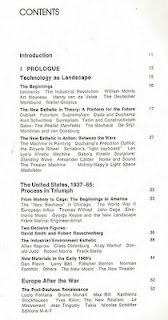Reminded me of this book I picked up recently:
Published in 1973, written most likely in 1970-71, and, crucially, based on the 1960s.
As the contents pages indicate:
Like so many Zeitgeist-snapshot books (and there are loads of examples of this in terms of big-picture rock books - including a few of my own) it projects forward from what seem to be the most era-defining and progressive tendencies of the present (which by the time the book comes out is the immediate past). Except that by then, other and usually radically different tendencies have emerged. Art and the Future's "prophecy" doesn't envision things like body art, performance art, appropriation art, or indeed most of the major trends and directions that would transpire in the Seventies and thereafter.
But it's full of exciting photographs and reproductions of work by artists, mostly long forgotten, that impart a retro-future frisson - specimens of kinetic art, computer art, early video art, and some of the same people covered by the Ghosts in the Machine exhibition, such as Hans Haacke. I've been meaning to scan some of them in here, but in the meantime, here's a few from the web.
This first one is from Art and the Future itself
The rest are pictures, or Youtubes, of works by artists covered in the book.

Nicolas Schöffer was a musician as well as a kinetic art pioneer, and some years ago I stumbled on this record (later to be Creel Pone-d)
Released in 1979 on the Hungaroton label, it's an attempt to translate his plastic arts oriented theories about color and structure and space into sound: "to construct trapped time--in the same way as trapped space or trapped light information." The austere pulses and pure poised tones of pieces like "Chronosonor 5" are not so much music as sonic mobiles hanging in space.












2 comments:
v. interesting Simon.
Re, Douglas Davis. Back in the early '70s, he was considered one of the pioneering video artists of the day, if not one of the fledgling medium's leading theoreticians. But his legacy seems to faded in the decade that followed, because I've seldomly seen him cited over the years. Long ago, I used to have a book of his various essays and art writings, none of which had dated very well. I'd never seen (or even heard about) the "Art and the Future" title.
Post a Comment